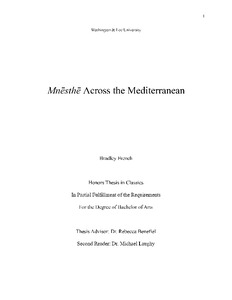Mnesthe Across the Mediterranean (thesis)

View/
Author
French, Virginia Bradley
Subject
Washington and Lee University -- Honors in Classics
Graffiti
Syria -- Dura-Europos (Extinct city)
Metadata
Show full item recordDescription
Thesis; [FULL-TEXT FREELY AVAILABLE ONLINE] Virginia Bradley French is a member of the Class of 2022 of Washington and Lee University. Dura has preserved-and archaeology has unearthed-the largest concentration of mnesthe graffiti, a simple yet distinctive type of inscription found throughout the ancient Mediterranean. . . . Since more than 45% of the 219 inscriptions were discovered at the site of Dura-Europos, this city is the ideal starting point for an inquiry into the meaning and presence of a popular inscription the usage of which spans several centuries and hundreds of miles. In this thesis, I will analyze the mnesthe formula using 123 inscriptions from my corpus, all located in one of three areas. First, I will survey the 99 inscriptions at Dura-Europos which adhere to the formula, notable for its simplicity and its strong presence in the city. Then, I will discuss the 13 inscriptions at Grammata Bay in Epirus, the earliest appearances of the formula, which feature a slightly different format with a more religious role than the Durene graffiti. Finally, I'll discuss 11 graffiti from the Italian towns of Pozzuoli, Pompeii, and Oplontis, which represent a combination of and expansion on the trends visible in Epirus and Dura-Europos. Through the inscriptions in these locations I aim to track the evolution of the mnesthe format in graffiti from the fourth century BC to the third century AD and to consider possible explanations for how it spread and changed over the centuries. [From introductory section] Bradley French